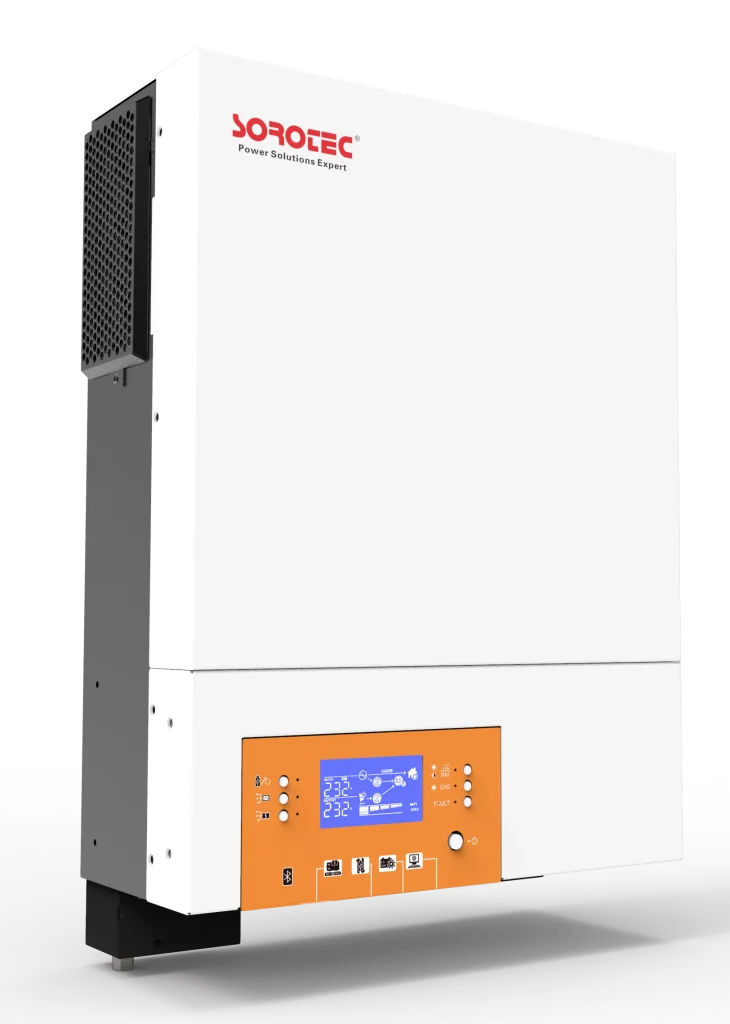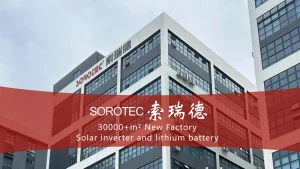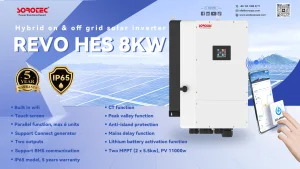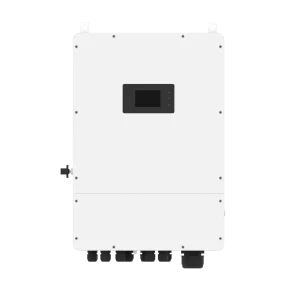Understanding inverter battery voltage is key to creating a strong and dependable power system. This detailed guide explores how to choose the right voltage, offers tips for specific uses, and shares care practices. It highlights SOROTEC’s cutting-edge solutions that are shaping the future of energy storage.
What is Inverter Battery Voltage?
The Basics of Inverter Battery Voltage
Inverter battery voltage is the electric force that drives the inverter system. It plays a big role in how well your energy setup works. The inverter’s voltage must match the battery bank’s voltage. This match ensures smooth energy conversion. It also reduces energy waste. If you use batteries, check their voltage rating. The inverter’s voltage should be the same as the battery bank’s. This alignment boosts performance and cuts losses.
Factors Influencing Optimal Voltage Selection
Several things affect choosing the best inverter battery voltage. These include the total power needed, the system’s design, and the specific use. For example, homes with smaller power needs may work well with a 12V system. However, businesses or factories often need 24V or 48V setups to handle bigger loads. Each choice depends on the system’s unique demands.
Common Voltage Ranges in the Market
Inverter batteries come in voltages like 12V, 24V, and 48V. For instance, a 3000W inverter might connect to a 12V battery pack, such as a 12V 200Ah deep cycle battery. This pack could be one 12V battery or several 12V batteries linked in parallel. Higher voltage systems, like 48V, suit large-scale uses. They lower the current flow and reduce energy loss during transmission.
How Do Voltage Requirements Vary Across Applications?
Residential Power Backup Systems
For homes, smaller power needs make 12V or 24V systems practical. These systems can power key appliances during outages. They don’t overload the setup. Choosing the right voltage ensures the system runs smoothly. It also saves money.
Commercial and Industrial Energy Solutions
Businesses and factories need more power due to heavy usage. A 48V system is often best here. It handles larger loads while staying efficient. High-voltage systems also produce less heat. This helps parts last longer.
Off-Grid Solar Systems
Off-grid solar setups use batteries with different voltages based on storage needs. The REVO VM III-T series works well for off-grid systems. Higher voltages, like 48V, are great for solar setups. They match solar charge controllers better. They also lower wiring costs.
What Makes SOROTEC’s Inverter Battery Solutions Stand Out?
Overview of SOROTEC’s Product Lineup
If you want reliable inverter battery solutions for various uses, SOROTEC is a top choice. They offer advanced technology for homes and businesses. Their creative designs ensure their products work with many setups. SOROTEC focuses on durability and efficiency.
Key Features of SOROTEC Inverter Batteries
SOROTEC batteries have special features. They include battery equalization, which helps batteries last longer. They also have reserved ports (RS485, CAN) for BMS integration. These batteries support a maximum PV input current of 27A. This matches market trends for higher Imp values in solar panels. Plus, users can access a global cloud platform via mobile apps. This allows remote monitoring, making things easier.
Compatibility with Various System Configurations
SOROTEC batteries fit into many energy setups. These range from home backup systems to large off-grid projects. Their modular designs let users scale up as energy needs grow. This flexibility makes them a great choice.
Recommended Voltage Options for Specific Use Cases
High-Performance Models for Large-Scale Applications
For factories or big off-grid setups, SOROTEC offers high-voltage options like 48V models. These support up to 7000W output. They ensure strong performance under heavy loads. They also convert energy efficiently.
Energy-Efficient Options for Residential Use
Home users benefit from SOROTEC’s energy-saving solutions. These suit moderate power needs. Some models have a second output feature. This lets users schedule on/off times based on battery levels. It improves energy use without hurting performance.
Evaluating the Performance of SOROTEC Inverter Batteries
How Efficient and Reliable Are These Batteries?
Efficiency and reliability matter a lot when judging inverter batteries. Efficiency shows how well a battery turns stored energy into usable power. Reliability ensures steady performance over time. SOROTEC batteries handle a maximum PV input current of 27A. This aligns with trends for higher Imp values in solar panels. It boosts compatibility with modern solar setups. It also improves energy conversion. Battery equalization extends battery life. This makes them dependable for long-term use.
Reliability gets a boost from smart design features. Reserved ports (RS-485, CAN) allow easy monitoring and management. These ensure the system works well under different loads. The global cloud platform, accessible via mobile apps, offers real-time insights. This adds another layer of dependability.
What Is the Impact of Voltage on Battery Lifespan and Performance?
Voltage greatly affects a battery’s lifespan and performance. The inverter’s voltage must match the battery bank’s voltage. If you use batteries, check their voltage rating. The inverter’s voltage should be the same. A mismatch can cause inefficiencies. It might even damage parts.
Higher voltage systems, like 48V, are great for big applications. They reduce current flow. This lowers heat and energy loss. Less heat means less wear on battery parts. This extends the battery’s life and improves performance.
Best Practices for Selecting and Maintaining Inverter Batteries
Choosing the right voltage for your power system is vital. It affects efficiency, performance, and safety. This section shares key tips for homes and businesses.
How Do You Choose the Right Voltage?
Matching System Requirements with Battery Specifications
Picking the right voltage starts with knowing your system’s needs. Homes often work well with 12V or 24V systems. These suit smaller power demands. For example, a 3000W inverter might use a 12V battery pack, like a 12V 200Ah deep cycle battery. This could be one battery or several in parallel. Businesses or factories usually need 48V systems. These handle bigger loads well.
Considering Load Demand and Backup Duration
Your load demand and backup time also guide voltage choice. Higher capacity batteries work better for long backup times or heavy uses. Some SOROTEC models have a second output feature. This lets users schedule on/off times based on battery levels. It ensures smart energy use without losing performance.
What Maintenance Tips Optimize Battery Performance?
Regular care is key to keeping inverter batteries efficient and long-lasting. Check all connections often. Make sure they’re tight and free of rust. If your battery uses electrolytes, check their levels regularly. Clean terminals to avoid buildup that could hurt performance. SOROTEC’s battery equalization feature helps extend battery life. Use it if available.
Remote monitoring tools, like SOROTEC’s global cloud platform, make maintenance easier. They provide real-time data on battery health. This helps you spot issues early. It reduces downtime and boosts reliability.
Future Trends in Inverter Battery Technology
What Innovations Are Emerging in Voltage Regulation?
New advances in voltage regulation are making inverter batteries better. Smart load management systems let users control energy use based on needs. For example, the second output can turn on or off based on battery levels. This saves energy and reduces strain during peak times. It also helps batteries last longer.
Adaptive charging technology is another exciting development. It adjusts charging based on the environment or load needs. This reduces wear on battery parts. It also maximizes energy storage.
Which Technologies Are Shaping SOROTEC’s Product Development?
SOROTEC leads the way in using new technology. Their modular designs allow easy scaling for growing energy needs. They work with many setups. The OFF-Grid REVO VM III-T series is ideal for off-grid systems.
SOROTEC is exploring AI-driven energy management systems. These could improve user convenience and system efficiency. By adopting these technologies, SOROTEC sets high standards for inverter battery performance and reliability.
FAQ
Q1: How does matching voltage ratings improve system efficiency?
A: Aligning the inverter’s voltage with the battery bank’s voltage reduces energy waste. It ensures smooth operation.
Q2: What role do higher voltages play in large-scale applications?
A: Higher voltages, like 48V, lower current flow. They reduce energy loss and heat. This improves efficiency and extends part life.
Q3: Can remote monitoring tools enhance maintenance practices?
A: Yes, remote monitoring gives real-time data on battery health. It makes maintenance easier and more effective.










